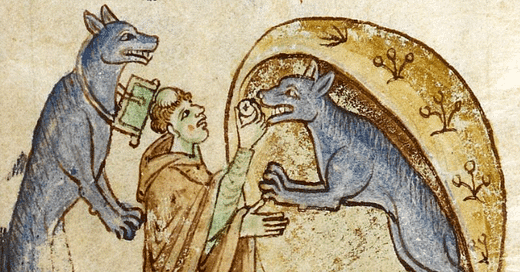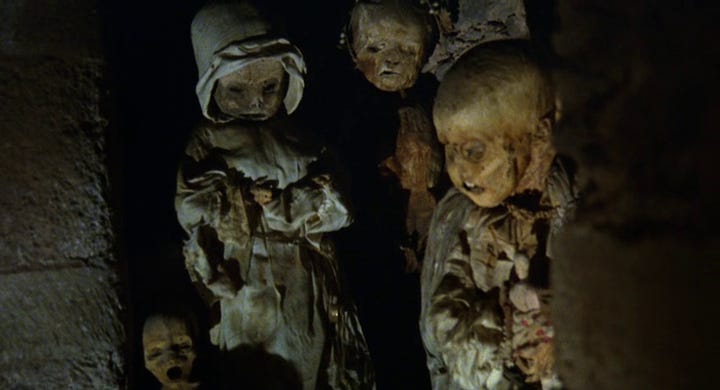It’s easy to view Giraldus Cambrensis’s twelfth-century manuscript (Topographia Hibernica / Topography of Ireland) as a colonialist manifesto meant to encourage an Anglo-Norman invasion of Ireland. It’s easy to view it this way because that is exactly what it was. Any doubt as to Gerald’s intentions can be erased by looking at some of the chapter headings from his next book, the less successful Expugnatio Hibernica: ‘In what manner Ireland is to be completely conquered’ reads the heading for chapter thirty-six. This is followed by the final chapter: ‘How Ireland ought to be governed’. In his Topography it is clear that Gerald was more than happy to include any outlandish tall tale that fit with the narrative that the Irish were nothing more than a shower of misbehaving savages in want of an external civilizing force. Throughout the middle section of his account, bizarre occurrences abound: a woman has intercourse with a goat, a fish is discovered with three golden teeth, a priest converses with a wolf and a strange island prohibits entry to “any animal of the female sex”. All this contributes to a rich tapestry of surreal barbarity. It is also, however, a fascinating read. (For more on Topographia Hibernica you could do a lot worse than checking out this episode of The Blindboy Podcast here.).
When I started working on my second poetry collection (Let the Dead, Banshee Press, 2023) I knew I wanted to research the history, mythology and legends of Ireland to see what could happen if I were to bring them into dialogue with stories from the country in which I have spent much of my adult life: Mexico. Though not an Irish book, the Topographia kept rearing its head, demanding my attention and, so I ended up using it as one might use any source, focusing on that which could enrich the themes of my book, namely progeneration, death and regeneration. I found stories of an island in which corpses do not decay and couldn’t help remember the mummies of Guanajuato (as filmed by Werner Herzog in his exquisite version of Nosferatu), preserved by the peculiarities of the local soil. I read about decapitating grasshoppers and was brought to the markets of Oaxaca (and further, into the darker recesses of recent Mexican histories of narco-brutality). I loved the story of the boy who swallowed a snake in Britain and had to make his way to Ireland (where snakes cannot survive) so that the creature would die and, thus, evacuate the body. These ideas led to some of the poems in Let the Dead.
I first came across Gerald’s Topographia via Jorge Fondebrider’s history of lycanthropes (Licantropía. Historias de hombres lobo de Occidente, 2004) in which reference is made to Gerald’s account of a priest who meets and then converses with a wolf. I imagined the ancient Irish wolfman as once having protected the human leaders of the south-east before falling from grace and, ultimately, having to stuff envelopes in Kilkenny County Council in order to make ends meet. The poem was one of the first I wrote after my first collection, Blood Oranges (The Dreadful Press, 2014) and was published by Billy Ramsell in The Stinging Fly. Ultimately, like quite a few other poems I wrote inspired by the Topography, it simply did not fit the mood of Let the Dead, too tonally different. I am, however, including it here for readers to (hopefully) enjoy. You’ll need to turn your phone sideways or read on a laptop/wide screen.
Let the Dead is available now from Banshee Press here: https://www.bansheelit.com/shop/p/let-the-dead-by-dylan-brennan
THE WOLF OF OSSORY
(OR: Of the prodigies of our times, and first of a wolf which conversed with a priest)
forgive me father I am a wolf & you can call me Borris
in the grounds of Jerpoint Abbey I once mauled a gerrymanderer
I cannot leave I'm tied to Ossory
I protected Cearbhall by shield-light
(he couldn't take me with him take me with him to Orkney)
when a full moon comes around
I get blotto in Tynan's so maybe fuck up a sheep or two
a drunken howl does less damage
I'm a supernatural being loyal lycanthrope
a thing that's a thing of the past
made to serve the masters I stuff envelopes
in Kilkenny County Council
no kings left to bodyguard
you can't need what you can't believe
I'll tell you things you already know
Cúchulainn was a dog-man he knew my cousin
he loved to gnaw on a sliotar
I was born in the Slieve Blooms baptised in the cold knuckles of the Nore
I coach camogie down at Mooncoin
& in my free time I lap up the fresh sources of all Three Sisters
I'll serve no more I go out running every night








What was the wolf species called